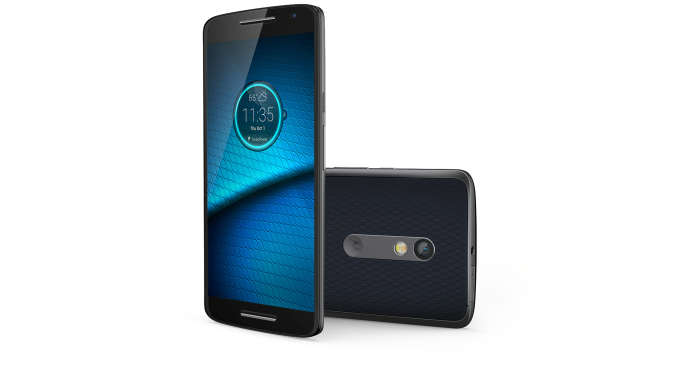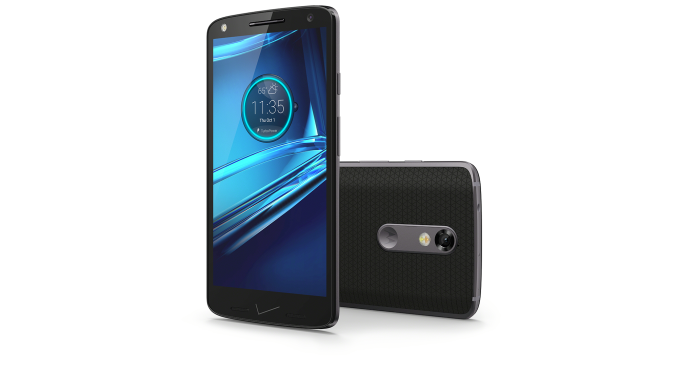Motorola Announces the DROID Turbo 2 and DROID Maxx 2 For Verizon
by Brandon Chester on October 27, 2015 1:12 PM EST- Posted in
- Smartphones
- Verizon
- Motorola

Motorola has been one of Verizon's Android device partners for many years now. Before Verizon had the iPhone, Motorola's DROID smartphones provided several alternatives for users who didn't want to leave Verizon, or who wanted the features or differentiation provided by Android smartphones. While the DROID line isn't what it once was, there are still DROID branded smartphones made by Motorola launched on Verizon every year. Today Verizon and Motorola announced two devices that follow up on the original DROID Turbo and DROID Maxx. Appropriately, the new phones are called the DROID Turbo 2 and the DROID Maxx 2, and you can view their specs in the chart below.
| DROID Turbo 2 | DROID Maxx 2 | |
| SoC | Qualcomm Snapdragon 810 | Qualcomm Snapdragon 615 |
| GPU | Adreno 430 | Adreno 405 |
| RAM | 3GB LPDDR4 | 2GB LPDDR3 |
| NAND | 32/64GB + MIcroSDXC | 16GB + MicroSDXC |
| Display | 5.4" 2560x1440 AMOLED | 5.5" 1920x1080 IPS LCD |
| Dimensions | 149.8 x 78 x 7.6-9.2mm, 169g | 148 x 75 x 8.9-10.9 mm, 169g |
| Camera | 21MP Rear-Facing, F/2.0 5MP Front-Facing |
|
| Battery | 3760 mAh | 3630 mAh |
| OS | Android 5.1.1 Lollipop | |
| Cellular Connectivity | 2G / 3G / 4G LTE (Qualcomm UE Category 7/9) | 2G / 3G / 4G LTE (MDM9x25 Category 4) |
| Other Connectivity | 2x2 802.11a/b/g/n/ac + BT 4.0, microUSB 2.0, GNSS | 2x2 802.11a/b/g/n + BT 4.0, microUSB 2.0, GNSS |
| SIM | Nano-SIM | |
| Price | 32GB: 24 months @ $24 ($576 Total) 64GB: 24 months @ $30 ($720 Total) |
16GB: 24 months @ 16 ($384 Total) |
It's clear that the DROID Maxx 2 is positioned as more of a mid-range device, with the DROID Turbo 2 at the high end. Both devices are similar as far as their size, mass, and battery capacity is concerned. While the Turbo 2 is actually slightly thinner and has a smaller display than the Maxx 2, the height and width of the chassis are a bit longer. The display on the Turbo 2 is also a QHD AMOLED panel, while the Maxx 2 is a 1080p IPS LCD.
The display on the DROID Turbo 2 is actually the device's selling point, although when saying the word display it's not necessarily referring to the display panel used. Instead, the unique part about this display is the fact that Motorola claims that it's shatterproof. Unlike a typical smartphone display stack, the Turbo 2's Moto ShatterShield display consists of several layers which are designed to absorb the shock of an impact. Instead of a single cover glass, the Turbo 2 has an exterior lens that sits overtop of an interior lens, with both being significantly more flexible than traditional cover glass. Motorola also has an additional touch layer to create redundancy if one is damaged during an impact, and the flexible AMOLED display also works to protect from damage.
Motorola DROID Turbo 2
Motorola claims that the exterior and interior lenses are designed to have the highest degree of optical transmissivity, but it's likely that there will be some degree of reduction in transmissivity when compared to standard smartphone displays. Reflections will also be amplified, and since there are gaps between the layers you'll be dealing with internal reflection which could make the display more difficult to use in heavy ambient lighting. As of right now it's really hard to say what impact Motorola's ShatterShield display has on visual quality, but it seems safe to assume that both Motorola and Verizon are confident about its ability to protect against damage as they are providing a four year warranty specifically for if the display does crack or shatter.
Since the DROID Turbo 2 is a Verizon exclusive smartphone, it's hard to say if or when we'll see Motorola bring their ShatterShield displays to products that ship on a wider scale. It's possible that the launch in the DROID Turbo 2 is a method of testing how consumers respond to the feature and how much demand there will be. I personally have done well by just not dropping my phones, but obviously accidents do happen and it only takes a single drop to ruin a perfect record and leave you with a shattered display.
Anyone interested in the DROID Turbo 2 or DROID Maxx 2 can get them in two days if they're on Verizon in the US. On a 24 month installment plan the Turbo 2 is $24 per month for the 32GB model, or $30 per month for the 64GB model, while the DROID Maxx 2 is $16 per month.











22 Comments
View All Comments
cmikeh2 - Wednesday, October 28, 2015 - link
I wouldn't quote me on this, but my guess is that they had originally planned to have a speaker grill across the bottom like the top, and when Verizon told them to put the logo on front they just split the grill and moved it to the side. The material looks a lot like the grill on the top half of the device.WithoutWeakness - Tuesday, October 27, 2015 - link
Still has the old Verizon check-mark logo. I know this phone has probably been in production for a little while now in order to build up enough stock to get it on sale by the end of October but it's odd to see a new product launching with the old logo 2 months after they changed it.Interesting that the Maxx 2 appears to be just a rebrand of the Moto X Play but the Turbo 2 is a totally separate device from the Moto X Style/Pure.
Gunbuster - Tuesday, October 27, 2015 - link
No love for mentioning it supports Qi?Bob Todd - Tuesday, October 27, 2015 - link
Pricing for both seems terrible. $720 for the 64GB Turbo 2 when a 64GB Moto X Pure is $500 or a 128GB Nexus 6P is $650? $384 for the lower mid-range guts Maxx vs. $400 for a 16GB Moto X? I love big batteries, but unless the installment plan pricing is way more than the one-time cost these are wack.UtilityMax - Saturday, November 7, 2015 - link
Indeed, these days you can buy ASUS Zenfone 2 Laser with the same 615 SoC for $200-250, OnePlus One with SoC nearly as fast as 810 still sells for $300. Too bad the later won't work on Verizon network, I think.tolud - Wednesday, October 28, 2015 - link
the specifications are ok, but consider the price,it's too much. i would prefer to select OP2 or Bluboo Xtouch if i want to have a anti-drop phone at a good price. $384 ? thank you !andrewcen - Thursday, October 29, 2015 - link
I don't like the appearance , also the price is also high, not deserve this priceNow I am considering to buy a xiaomi or Bluboo Xtouch which also have 3+32, octa core 64bit, dual sim card and FHD IPS scree
kamm2 - Thursday, October 29, 2015 - link
Very disappointed in the Maxx 2 having 16GB of internal storage. Needs to be 32GB.jhh - Friday, October 30, 2015 - link
Marshmallow is supposed to allow treating the SD card like internal storage if formatted with the Ext3 filesytem. If this works right, you can buy your own SD card for much less than it costs for more integrated flash. Not sure when Marshmallow will hit these phones, though.nirvana11 - Saturday, November 7, 2015 - link
This is one ugly looking phone. The pictures in this article are far better than the reality.